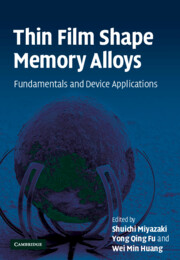Book contents
- Frontmatter
- Contents
- List of contributors
- Preface
- Abstracts of chapters
- 1 Overview of sputter-deposited TiNi based thin films
- 2 Martensitic transformation in TiNi alloys
- 3 Deposition techniques for TiNi thin film
- 4 TiNi multilayer thin films
- 5 Crystallization and microstructural development
- 6 Mechanical properties of TiNi thin films
- 7 Stress and surface morphology evolution
- 8 Ion implantation processing and associated irradiation effects
- 9 Laser post-annealing and theory
- 10 Overview of thin film shape memory alloy applications
- 11 Theory of SMA thin films for microactuators and micropumps
- 12 Binary and ternary alloy film diaphragm microactuators
- 13 TiNi thin film devices
- 14 Shape memory microvalves
- 15 Superelastic thin films and applications for medical devices
- 16 Fabrication and characterization of sputter-deposited TiNi superelastic microtubes
- 17 Thin film shape memory microcage for biological applications
- 18 Shape memory thin film composite microactuators
- 19 TiNi thin film shape memory alloys for optical sensing applications
- Index
16 - Fabrication and characterization of sputter-deposited TiNi superelastic microtubes
Published online by Cambridge University Press: 23 February 2010
- Frontmatter
- Contents
- List of contributors
- Preface
- Abstracts of chapters
- 1 Overview of sputter-deposited TiNi based thin films
- 2 Martensitic transformation in TiNi alloys
- 3 Deposition techniques for TiNi thin film
- 4 TiNi multilayer thin films
- 5 Crystallization and microstructural development
- 6 Mechanical properties of TiNi thin films
- 7 Stress and surface morphology evolution
- 8 Ion implantation processing and associated irradiation effects
- 9 Laser post-annealing and theory
- 10 Overview of thin film shape memory alloy applications
- 11 Theory of SMA thin films for microactuators and micropumps
- 12 Binary and ternary alloy film diaphragm microactuators
- 13 TiNi thin film devices
- 14 Shape memory microvalves
- 15 Superelastic thin films and applications for medical devices
- 16 Fabrication and characterization of sputter-deposited TiNi superelastic microtubes
- 17 Thin film shape memory microcage for biological applications
- 18 Shape memory thin film composite microactuators
- 19 TiNi thin film shape memory alloys for optical sensing applications
- Index
Summary
Abstract
A novel method of fabricating TiNi superelastic microtubes with a dimension of less than 100 μm is presented in this chapter. The method was carried out by sputter-deposition of TiNi on a Cu-wire substrate, and after deposition the Cu wire was removed by etching to produce a tube hole. The shape-memory/superelastic behavior and fracture strength of the microtubes were characterized. The factors affecting the properties and a method to produce high-strength superelastic TiNi microtubes are discussed.
Introduction
Superelastic microtubes are attractive materials for application in the medical industry due to the increasing demands for less-invasive surgical devices, such as stents, catheters, microneedles, etc. Among many alloy systems that exhibits superelastic behavior, TiNi shape memory alloy is considered the most prominent due to its superior properties, such as large and stable superelastic strain [1, 2], excellent mechanical properties and relatively good biocompatibility [3]. Commercially available TiNi microtubes are usually processed by a tube-drawing method [4, 5, 6, 7, 8]. The available size of tubes that can be fabricated by tube drawing is limited to larger than 200 μm in outer-diameter and a wall thickness of 50 μm. A superelastic microtube with dimensions less than 200 μm has the potential to further miniaturize microdevices and thereby increasing their applicability.
A novel method to fabricate TiNi microtubes with dimensions less than 100 μm was suggested by utilizing a sputter-deposition method [9, 10]. The contents of this chapter are based on Ref. [9]. In this method a Cu-wire (diameter 50 μm) is used as a substrate and it was completely covered with TiNi by sputter-deposition. After deposition the Cu-wire was completely removed by etching to produce the tube hole.
- Type
- Chapter
- Information
- Thin Film Shape Memory AlloysFundamentals and Device Applications, pp. 385 - 402Publisher: Cambridge University PressPrint publication year: 2009



